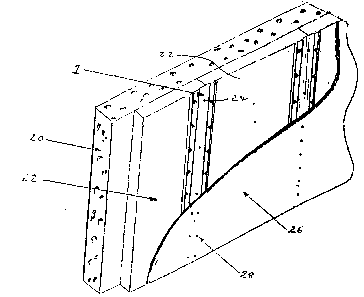Some of the information on this Web page has been provided by external sources. The Government of Canada is not responsible for the accuracy, reliability or currency of the information supplied by external sources. Users wishing to rely upon this information should consult directly with the source of the information. Content provided by external sources is not subject to official languages, privacy and accessibility requirements.
Any discrepancies in the text and image of the Claims and Abstract are due to differing posting times. Text of the Claims and Abstract are posted:
| (12) Patent: | (11) CA 1262026 |
|---|---|
| (21) Application Number: | 1262026 |
| (54) English Title: | WALL INSULATION SYSTEM |
| (54) French Title: | SYSTEME D'ISOLANT MURAL |
| Status: | Expired and beyond the Period of Reversal |
| (51) International Patent Classification (IPC): |
|
|---|---|
| (72) Inventors : |
|
| (73) Owners : |
|
| (71) Applicants : | |
| (74) Agent: | |
| (74) Associate agent: | |
| (45) Issued: | 1989-10-03 |
| (22) Filed Date: | 1988-03-25 |
| Availability of licence: | N/A |
| Dedicated to the Public: | N/A |
| (25) Language of filing: | English |
| Patent Cooperation Treaty (PCT): | No |
|---|
| (30) Application Priority Data: | None |
|---|
Abstract
The present invention provides a system or assembly,
intended to overcome the disadvantages. It provides a wall
assembly, which comprises insulation boards assembled to
form a layer of insulation; a generally flat channel, having
a series or bonds to provide structural strength and also
having a series of regularly spaced teeth or projections
punched along the length of metal channel adapted to be
pressed into the insulation board; and fastening elements
for holding the channel sections in position, securing insul-
ation boards to a wall structure. There is also provided a
generally flat shaped channel member having a central port-
ion, and extending parallel to one another and generally
parallel to the central portion two side flanges which both
lay flat on the surface of the insulation boards to provide
additional structural strength to both the channel member
itself and the wall system overall.
Note: Claims are shown in the official language in which they were submitted.
Note: Descriptions are shown in the official language in which they were submitted.

2024-08-01:As part of the Next Generation Patents (NGP) transition, the Canadian Patents Database (CPD) now contains a more detailed Event History, which replicates the Event Log of our new back-office solution.
Please note that "Inactive:" events refers to events no longer in use in our new back-office solution.
For a clearer understanding of the status of the application/patent presented on this page, the site Disclaimer , as well as the definitions for Patent , Event History , Maintenance Fee and Payment History should be consulted.
| Description | Date |
|---|---|
| Inactive: IPC from MCD | 2006-03-11 |
| Time Limit for Reversal Expired | 2005-10-03 |
| Inactive: Adhoc Request Documented | 2005-07-06 |
| Inactive: Payment - Insufficient fee | 2004-10-26 |
| Letter Sent | 2004-10-04 |
| Grant by Issuance | 1989-10-03 |
There is no abandonment history.
| Fee Type | Anniversary Year | Due Date | Paid Date |
|---|---|---|---|
| MF (category 1, 8th anniv.) - small | 1997-10-03 | 1997-09-23 | |
| MF (category 1, 9th anniv.) - small | 1998-10-05 | 1998-07-21 | |
| MF (category 1, 10th anniv.) - small | 1999-10-04 | 1999-08-12 | |
| MF (category 1, 11th anniv.) - small | 2000-10-03 | 2000-09-25 | |
| MF (category 1, 12th anniv.) - small | 2001-10-03 | 2001-07-20 | |
| MF (category 1, 13th anniv.) - small | 2002-10-03 | 2002-08-06 | |
| MF (category 1, 14th anniv.) - small | 2003-10-03 | 2003-07-28 |
Note: Records showing the ownership history in alphabetical order.
| Current Owners on Record |
|---|
| PETER THOMAS KOSTEK |
| Past Owners on Record |
|---|
| None |